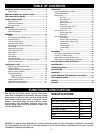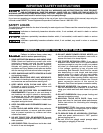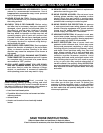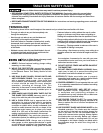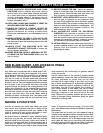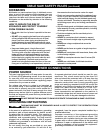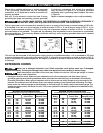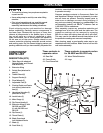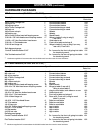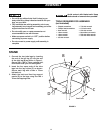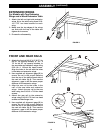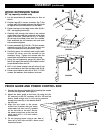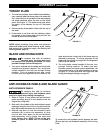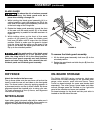
GENERAL POWER TOOL SAFETY RULES
4
SAVE THESE INSTRUCTIONS.
Refer to them often and use them to instruct others.
If tool is loaned to someone, also loan them these instructions.
PROPOSITION 65 WARNING:
Dust created by
power sanding, sawing, grinding, drilling, and other
construction activities may contain chemicals known to
the state of California to cause cancer, birth defects or
other reproductive harm. Some examples are:
• Lead from lead-based paints
• Crystalline silica from bricks and cement and other
masonry products
• Asbestos dust
• Arsenic and chromium from chemically-treated
lumber
Your risk from these exposures varies depending on
how often you do this type of work. To reduce your
exposure to these chemicals: work in a well-ventilated
area and work with approved safety equipment, such
as dust masks that are specially designed to filter out
microscopic particles.
18. USE RECOMMENDED ACCESSORIES. Consult
manual for recommended accessories. Use of
inappropriate accessories may cause personal
injury or property damage.
19. NEVER STAND ON TOOL. Serious injury could
occur if the tool tips or if you unintentionally contact
the cutting surface.
20. CHECK TOOLS FOR DAMAGE. Before using,
and after tool or accessory has been dropped or
damaged, check guards and affected parts for
alignment of moving parts, binding of moving
parts, breakage of parts, and any other condition
that may affect its operation to make sure tool will
operate properly and all parts will perform their
intended function. Do not use a damaged product.
A guard or any other part that is damaged should
be properly repaired or replaced using factory-
approved service parts.
21. USE PROPER FEED DIRECTION. Feed workpiece
against the direction of rotation of the tool’s blade,
cutter, or abrasive surface. Feeding in the other
direction may cause the workpiece to be thrown at
high speed.
22. NEVER LEAVE TOOL RUNNING UNATTENDED.
TURN POWER OFF. Do not leave tool until it comes
to a complete stop. In the event of a power failure,
move switch to “OFF” position.
23. STAY ALERT, WATCH WHAT YOU ARE DOING,
AND USE COMMON SENSE. Do not use power
tools when tired or under the influence of drugs,
alcohol, or medication. A moment of inattention
while operating power tools may result in injury.
24. SERVICE PARTS. Use only identical replacement
parts when servicing your tool.
25. WEAR PROPER APPAREL. Do not wear loose
clothing, gloves, neckties, rings, bracelets, or other
jewelry which may get caught in moving parts.
Nonslip protective footwear is recommended. Wear
protective hair covering to contain long hair.
26. WEAR PROPER EYE PROTECTION. All persons
in work area should wear safety glasses with side
shields. Everyday eyeglasses with impact resistant
lenses are not safety glasses. Eye equipment
should comply with ANSI Z87.1 standards.
27. HEARING PROTECTION. All people in work area
should wear proper hearing protection consistent
with noise levels and exposure. Hearing equipment
should comply with ANSI S3.19 standards.
28. DUST PROTECTION. Use of power tools can
generate and/or disburse dust, which may cause
serious and permanent respiratory or other injury,
including silicosis (a serious lung disease), cancer,
and death. Direct particles away from face and
body. Always operate tool in well-ventilated area
and provide for proper dust removal. Use dust
collection system whenever possible. Avoid
breathing dust and avoid prolonged contact with
dust. Allowing dust to get into your mouth or eyes,
or lay on your skin may promote absorption of
harmful material. Use properly fitting NIOSH/OSHA
approved respiratory protection appropriate for the
dust exposure and wash exposed areas with soap
and water.




